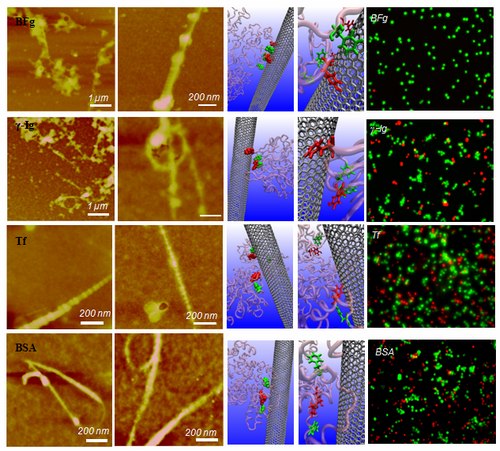Human blood system might establish new defensive measures against foreign nanomatetials
A research team from the Key Laboratory for Biomedical Effects of Nanomaterials and Nanosafety (LBEN), Chinese Academy of
 |
| Interactions between BFG, Ig, Tf, BSA, and SWCNTs. AFM images of proteins after incubation with SWCNTs for 10 min (A) and 5 h (B). |
The research progress was published on the paper entitled Binding of Blood Proteins to Carbon Nanotubes Reduces Cytotoxicity, on the Proceedings of the National Academy of Sciences (PNAS doi:10.1073/pnas.1105270108, 2011).
In this study, scientists used both experimental and theoretical approaches, including atomic force microscope images, fluorescence spectroscopy, CD, SDS-PAGE, and molecular dynamics simulations, to investigate the interactions of single-wall carbon nanotubes (SWCNTs) with human serum proteins, and found a competitive binding of these proteins with different adsorption capacity and packing modes.
Scientists demonstrated the interaction processes between SWCNTs and the main human blood proteins (like fibrinogen, immunoglobulin, albumin, transferring and ferritin) could reduce the cytotoxicity of SWCNTs. The selective binding of these proteins on the SWCNT surface can affect the cellular responses and result in different cytotoxicity. Further analysis showed that the π–π stacking interactions between SWCNTs and aromatic residues (Trp, Phe, Tyr) play a critical role in their binding capabilities. The findings in this research might provide more insight into our understanding of how to preconsider and design the safe surface of nanoparticles in biomedical applications.
Carbon nanotubes (CNTs) have a broad range of potential applications, including nanoelectronics, biosensors, biomolecular recognition devices and molecular transporters and cancer therapy and diagnoses, because of their extraordinary mechanical, electronic, optical, geometric, and biological properties. These findings have shed light toward the design of safe carbon nanotube nanomaterials by comprehensive preconsideration of their interactions with human serum proteins.
Dr. ZHAO Yuliang, Director of CAS Key Laboratory for Biomedical Effects of Nanomaterials and Nanosafety, introduced that in their evolutionary process, human beings have developed a series of defensive system to prevent from the damage of foreign matters. It is unclear that if human developed its effective defense system against tiny matter likes nanoparticles. However, using the native matters (like blood proteins) interacting with the typical nano-character (large surface area) to reduce the cytotoxicity of exotic nanoparticles may be one of significant steps in building the in vivo defense system for exotic nanoscale matters. This topic is of great interesting and need in-depth studies in the future.
Key Laboratory for Biomedical Effects of Nanomaterials and Nanosafety has started the research on the analysis of biological effects of carbon nanonaterials since the year of 2001. As one of the achievements in the long-term, systematic studies, this research progress was selected as the highlight paper introduced on the latest PNAS.
The research project was strongly supported by Ministry of Science and Technology of the People's Republic of China, National Natural Science Foundation of China and Chinese Academy of Sciences.